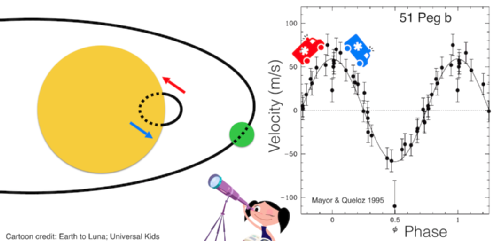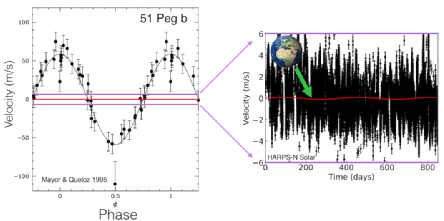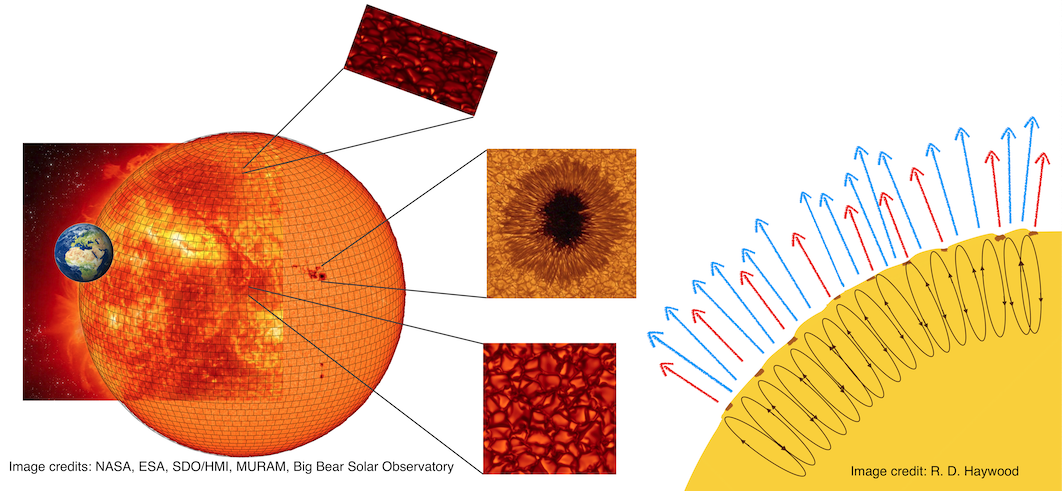Understanding Stellar Variability and Improving Exoplanet Characterisation
PhD project available in Dr CeglaLink opens in a new window's Towards Other Earths team, within the Astronomy GroupLink opens in a new window at the University of Warwick. Expected start date: October 2022. Check out the 1-minute summary:
Almost everything we know about exoplanets, those planets outside of our solar system, is derived from the stars they orbit. This is because, like our Sun relative to the Earth, the host stars vastly outshine any companion planets. As a result, inhomogeneities and variability on the surface of the host stars can significantly impair the ability to detect and characterise exoplanets; this is especially true for temperate, rocky planets as their signals are inherently small.
The end-state goal of this project is to improve the radial velocity detection of low-mass, long-period planets and to move us closer to enabling the future detection and confirmation of Earth-like alien worlds.
 The first exoplanet around a Sun-like star was discovered through the radial velocity technique (Mayor & Queloz 1995Link opens in a new window; see left), i.e. measuring the Doppler reflex motion induced in the host star by the planet as they orbit about their common centre of mass. Since this discovery we have come a long ways, detecting thousands of exoplanets and significantly improving the precision of our instruments. However, we are yet to find a true analogue to our Earth, the only known planet to support life. Thanks to instruments like the ESPRESSOLink opens in a new window spectrograph on the VLTLink opens in a new window, we now are within the technological capabilities to detect rocky, temperate planets around Sun-like stars, yet this remains an enormous challenge. Perhaps the biggest stumbling block on the pathway to habitable alien worlds originates from the host stars themselves.
The first exoplanet around a Sun-like star was discovered through the radial velocity technique (Mayor & Queloz 1995Link opens in a new window; see left), i.e. measuring the Doppler reflex motion induced in the host star by the planet as they orbit about their common centre of mass. Since this discovery we have come a long ways, detecting thousands of exoplanets and significantly improving the precision of our instruments. However, we are yet to find a true analogue to our Earth, the only known planet to support life. Thanks to instruments like the ESPRESSOLink opens in a new window spectrograph on the VLTLink opens in a new window, we now are within the technological capabilities to detect rocky, temperate planets around Sun-like stars, yet this remains an enormous challenge. Perhaps the biggest stumbling block on the pathway to habitable alien worlds originates from the host stars themselves.
 Inhomogeneities on the surfaces of the exoplanet host stars can produce spurious radial velocity signals that may mask or even mimic the Doppler wobble of an exoplanet. This happens both because the plasma on the stellar surface is moving, and thus emitting its own Doppler shifts, but also because magnetic field concentrations can suppress these motions and alter brightness of the surface in these regions. An example of the scale of the problem is shown to the right: where the signal from first exoplanet discovery (51 Peg b, a hot Jupiter) is shown to put things to scale, and data from the Sun (after all the solar system planet signals have been removed) is compared to the signal from an Earth-twin (shown in red); even though the uncertainties on a given measurement have improved dramatically (shown here is HARPS-N dataLink opens in a new window, a predecessor to ESPRESSO), the variability originating from the surface of the Sun is orders of magnitude larger than the ~9 cm/s Doppler wobble induced by the Earth. Check out recorded talks from the recent Sagan Summer Workshop on Extreme Precision Radial VelocitiesLink opens in a new window to dive into more details.
Inhomogeneities on the surfaces of the exoplanet host stars can produce spurious radial velocity signals that may mask or even mimic the Doppler wobble of an exoplanet. This happens both because the plasma on the stellar surface is moving, and thus emitting its own Doppler shifts, but also because magnetic field concentrations can suppress these motions and alter brightness of the surface in these regions. An example of the scale of the problem is shown to the right: where the signal from first exoplanet discovery (51 Peg b, a hot Jupiter) is shown to put things to scale, and data from the Sun (after all the solar system planet signals have been removed) is compared to the signal from an Earth-twin (shown in red); even though the uncertainties on a given measurement have improved dramatically (shown here is HARPS-N dataLink opens in a new window, a predecessor to ESPRESSO), the variability originating from the surface of the Sun is orders of magnitude larger than the ~9 cm/s Doppler wobble induced by the Earth. Check out recorded talks from the recent Sagan Summer Workshop on Extreme Precision Radial VelocitiesLink opens in a new window to dive into more details.
This project focuses on improving our knowledge of stellar physics so that we may disentangle stellar and planetary signals to enable the future confirmation and characterisation of rocky, temperate worlds around Sun-like stars. Almost all stellar variability is driven by the interplay between convection and magnetic fields; hence, understanding this interplay is key to unveiling low-mass, long-period planets. On the surface of our Sun, hot bubble of gas (known as granules) rise to the surface, cool, and fall back down into the star (within intergranular lanes); the uprising motions give rise to Doppler shifts towards the bluer end of the spectrum, while the falling motions shift the light towards the redder end of the spectrum (see below). This introduces asymmetries into the stellar absorptions lines used to measure Doppler shifts, as well as net shifts of several 10s of cm/s. If magnetic fields are present in strong concentrations, this can suppress the convective motions and induces shifts of several m/s.
This project can either take an observational or theoretical approach. In an observational approach we would study solar and stellar data from the world's leading instruments, including HARPS-N and with an additional focus towards improving the observing strategy for HARPS3 and the Terra Hunting Experiment. In a more theoretical approach, we would use state-of-the-art 3D magnetohydrodynamical (MHD) simulationsLink opens in a new window (two snapshots from such a simulation are shown below) to create the realistic stellar simulationsLink opens in a new window; this avenue would complement current work being done in our group. With either approach, the goal is to develop a toolkit to identify and mitigate stellar variability in exoplanet data, thereby pushing our detections levels even further and helping to open a pathway to the confirmation and characterisation of Earth-like alien worlds.

(Note the Earth is not to scale in the artist's impression on the left, and the schematic/cartoon on the right is a zoomed in portion of the Sun shown on the left to illustrate the Doppler shifts of individual granules; realistic depictions of these granules are shown in the two snapshots from 3D MHD simulations in the left, and can be compared to the empirical observation of the Sunspot, which is surrounded by these granules/convection)
To make an application, please complete the on-line forms linked from our Warwick Astronomy PhD Opportunities pageLink opens in a new window.
All applications must be submitted by January 9th 2024.
Please do not hesitate to contact Dr Cegla if you have any questions!
At the University of Warwick, we strongly value equity, diversity and inclusion, and the Physics Department will provide a healthy working environment, dedicated to outstanding scientific guidance, mentorship and personal development. We are committed to individuals with care giving duties and can offer flexible working hours.
Both the Physics Department and the University of Warwick hold Athena SWAN Silver awards, a national initiative to promote gender equality for all staff and students. The Physics Department is also a Juno Champion, which is an award from the Institute of Physics to recognise our efforts to address the under-representation of women in university physics and to encourage better practice for both women and men.
